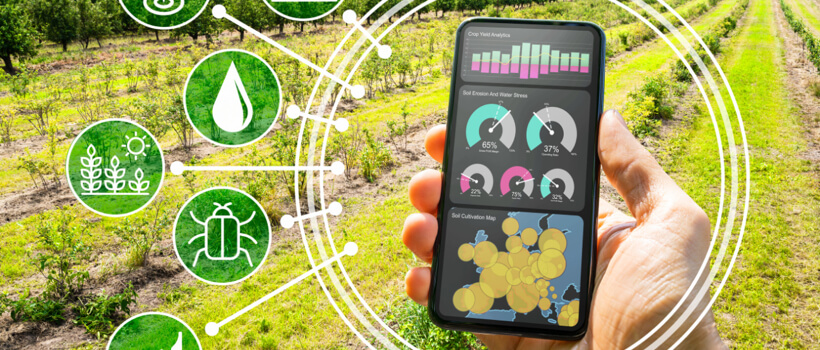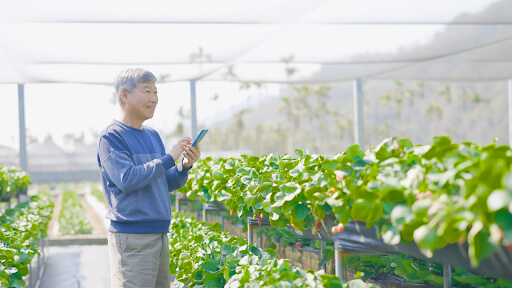 1-800-805-5783
1-800-805-5783 
As the global population expands, the efficient and sustainable utilization of agricultural land has become a critical societal goal. With the predicted surge in people over the next few decades, ensuring food security without compromising food safety remains a significant challenge.
Developed nations have increasingly focused on understanding the root causes of growing health issues among various populations worldwide. Research has often linked these health problems to unsafe farming practices, the consequences of the Green Revolution, and evolving environmental factors.
Sustainable farming practices are essential to address these challenges and ensure a sustainable food supply for a growing population. These practices aim to produce safe and nutritious food accessible to everyone at a reasonable cost.
AgriTech, the intersection of agriculture and technology, has emerged as a critical driver of sustainable farming. By leveraging innovative technologies, AgriTech solutions can help optimize resource use, reduce environmental impact, and improve food quality and safety.
According to the Global Safety Report, the challenge would be to feed about nine billion people by 2050 with the dwindling agricultural land resources and the ever-changing global climate.
Transforming traditional farming methods with advanced technology is reshaping agriculture, similar to the evolution of modern manufacturing. As we move beyond 2024, agriculture is becoming more adaptable and automated through cutting-edge tools like soil sensors, climate monitoring systems, AI-powered predictive models, and data-driven crop management techniques. These innovations drive greater efficiency, precision, and sustainability in farming practices.
As the global population grows and land resources become increasingly scarce, innovative farming methods are essential to ensure food security and sustainability. Here are some of the most promising farming methods that are being explored and implemented in 2024:
What emerging agricultural technologies are used with the farming methods mentioned above?

As the agricultural industry continues to evolve, various innovative technologies are used with the abovementioned farming methods. These technologies transform how we grow and produce food, increasing efficiency, sustainability, and resilience.
Here are some of the most promising emerging agricultural technologies:
Soil quality and water content influence crop yield and agricultural productivity. Using sophisticated crop sensors has become increasingly important in monitoring these parameters and ensuring optimal crop growth.
In 2024, advancements in sensor technology have enabled farmers to gain real-time insights into soil conditions and water usage. High-quality PAS CO2 sensors, specifically designed for agricultural applications and greenhouses, are now widely available and affordable. These sensors provide reliable data on carbon dioxide levels, which is a crucial factor in plant growth and photosynthesis.
Research and development efforts are focused on creating even more advanced sensor technologies, including AI-based solutions. These AI-powered sensors can help automate the monitoring and control of various agricultural parameters, such as fertilizer application, nitrogenous waste management, and toxic substance seepage into nearby water bodies. By optimizing these processes, farmers can reduce water pollution, minimize the overuse of fertilizers, and promote sustainable agricultural practices.
As highlighted in The Technology Quarterly, almond farmers in California have successfully benefited from using moisture sensors that transmit data through cloud networks. These sensors enable farmers to accurately assess the water required for irrigation, leading to significant water savings and improved crop yields.
Smart farming, powered by advanced technologies, rapidly transforms the agricultural landscape. One promising area of research is using programmable sequence-specific nucleases (PSSN) to manipulate biotic and abiotic crop factors. PSSN technology offers a more precise and efficient way to modify crop genomes than traditional genetic engineering techniques.
Agricultural biotechnology is also making significant strides in microbial research. Scientists are exploring the potential of beneficial microbes to enhance crop yield, reduce pesticide use, and improve plant resilience to harsh environmental conditions.
Multispectral sensors mounted on tractors can collect real-time data on crop nitrogen requirements. This data can be analyzed using cloud-based platforms, providing farmers with valuable insights for optimizing fertilizer applications.
Large IT companies are partnering with commercial farming units to develop sophisticated software platforms to process and analyze vast amounts of agricultural data. These platforms can help farmers make informed decisions and improve their operations.
Unmanned aerial vehicles (UAVs), known as drones, have become integral to modern agriculture. These AI-powered flying robots are equipped with sensors, cameras, and other technologies that enable them to perform various tasks, from crop monitoring to spraying and yield estimation.
Critical Benefits of Agricultural Drones:
The Future of Drone Technology in Agriculture
As technology advances, we can expect to see even more innovative applications of drones in agriculture. Some of the emerging trends include:
As the global population expands and land resources become increasingly scarce, the demand for increased agricultural output is more pressing than ever. To meet this challenge, modern, AI-driven farming practices are essential.
The future of agriculture envisions a day when the cropping cycle, from sowing to harvesting, is carried out with minimal human intervention. Advanced technologies such as robotics, drones, and artificial intelligence (AI) will be crucial in automating various agricultural tasks.
As AI-driven farming continues to evolve, we can expect to see even more innovative solutions that address the challenges of food security, sustainability, and climate change. By embracing these technologies, the agricultural industry can confidently meet the growing demand for food while minimizing its environmental impact.
Tags: agriculture, agritech